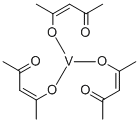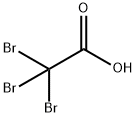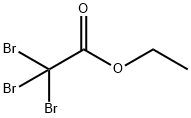Tribromoacetaldehyde
Synonym(s):Bromal
- CAS NO.:115-17-3
- Empirical Formula: C2HBr3O
- Molecular Weight: 280.74
- MDL number: MFCD00006961
- EINECS: 204-067-9
- SAFETY DATA SHEET (SDS)
- Update Date: 2025-07-04 15:25:53

What is Tribromoacetaldehyde?
Chemical properties
Oily, yellowish liquid. Soluble in water, alcohol, or ether. Combustible.
The Uses of Tribromoacetaldehyde
Organic synthesis.
Properties of Tribromoacetaldehyde
| Melting point: | -57.5 °C |
| Boiling point: | 174 °C(lit.) |
| Density | 2.665 g/mL at 25 °C(lit.) |
| refractive index | n |
| Flash point: | 150 °F |
| storage temp. | Refrigerator (+4°C) |
| Water Solubility | Soluble in water |
| Merck | 14,1383 |
| BRN | 1098614 |
| Dielectric constant | 7.6(21℃) |
| CAS DataBase Reference | 115-17-3(CAS DataBase Reference) |
| NIST Chemistry Reference | Acetaldehyde, tribromo-(115-17-3) |
| EPA Substance Registry System | Acetaldehyde, tribromo- (115-17-3) |
Safety information for Tribromoacetaldehyde
| Signal word | Danger |
| Pictogram(s) |
 Corrosion Corrosives GHS05  Skull and Crossbones Acute Toxicity GHS06 |
| GHS Hazard Statements |
H301:Acute toxicity,oral H310:Acute toxicity,dermal H314:Skin corrosion/irritation |
| Precautionary Statement Codes |
P280:Wear protective gloves/protective clothing/eye protection/face protection. P301+P330+P331:IF SWALLOWED: Rinse mouth. Do NOT induce vomiting. P303+P361+P353:IF ON SKIN (or hair): Remove/Take off Immediately all contaminated clothing. Rinse SKIN with water/shower. P305+P351+P338:IF IN EYES: Rinse cautiously with water for several minutes. Remove contact lenses, if present and easy to do. Continuerinsing. |
Computed Descriptors for Tribromoacetaldehyde
New Products
4,4-Difluoropiperidine hydrochloride tert-butyl 9-methoxy-3-azaspiro[5.5]undecane-3-carboxylate Indole Methyl Resin N-Isopropylurea N,N-Dicyclohexylcarbodiimide(DCC) MELDRUMS ACID 5-METHYLISOXAZOLE-4-CARBOXYLIC ACID Magnessium Bis glycinate Zinc ascorbate 1-bromo-2-butyne 2-acetamidophenol 9(10H)-anthracenone Erythrosin B, 4-Piperidinopiperidine 2-((4-morpholinophenylamino) (methylthio) methylene) malononitrile 2,4-dihydroxybenzaldehyde 3-(4-morpholinophenylamino)-5-amino-1H-pyrazole-4-carbonitrile Methyl 2-methylquinoline-6-carboxylate 2,6-dichloro-4-nitropyridine 4-Bromo-2-chlorobenzonitrile 2-(benzylamino)acetic acid hydrochloride 4-(tert-Butoxycarbonylamino)but- 2-ynoic acid 3,4-dihydro-2H-benzo[b][1,4]dioxepine 1-Phenyl-1-cycloprppanecarboxylicacidRelated products of tetrahydrofuran








You may like
-
 Bromal CAS 115-17-3View Details
Bromal CAS 115-17-3View Details
115-17-3 -
 Tribromoacetaldehyde CAS 115-17-3View Details
Tribromoacetaldehyde CAS 115-17-3View Details
115-17-3 -
 3-(4-amino-1-oxoisoindolin-2-yl)-1-methylpiperidine-2,6-dione 98%View Details
3-(4-amino-1-oxoisoindolin-2-yl)-1-methylpiperidine-2,6-dione 98%View Details -
 614-19-7 98%View Details
614-19-7 98%View Details
614-19-7 -
 20677-73-0 (2,2-diethoxyethyl)methylamine 98%View Details
20677-73-0 (2,2-diethoxyethyl)methylamine 98%View Details
20677-73-0 -
 3-(4-(hydroxyamino)-1-oxoisoindolin-2-yl)piperidine-2,6-dione 98%View Details
3-(4-(hydroxyamino)-1-oxoisoindolin-2-yl)piperidine-2,6-dione 98%View Details -
 57381-49-4 2-bromo-4-chlorobenzonitrile 98%View Details
57381-49-4 2-bromo-4-chlorobenzonitrile 98%View Details
57381-49-4 -
 4,6-dichloropyrimidine-5-carbaldehyde 98%View Details
4,6-dichloropyrimidine-5-carbaldehyde 98%View Details
5305-40-8
Statement: All products displayed on this website are only used for non medical purposes such as industrial applications or scientific research, and cannot be used for clinical diagnosis or treatment of humans or animals. They are not medicinal or edible.
